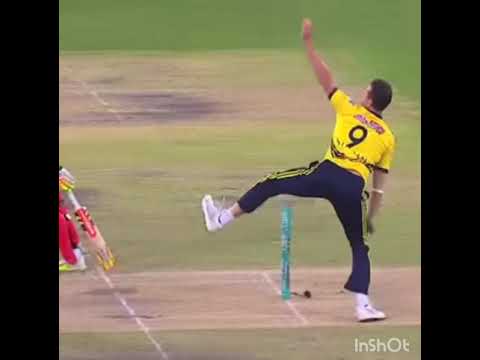I posed this question in my form thread but I feel like this area is a better discussion platform for it.
The gist of the idea is that in cricket, one prominent bowling coach divides bowlers into hip dominant or knee dominant mechanics. He then advises a framework for mechanics work with this in mind:
This is described as the traditional, "textbook" mechanism and is the predominant form in professional bowlers. Mechanically they behave very similarly to a javelin thrower and use tension/fascia driven moves to bowl with good posture. Hip dominant bowlers tend to be tall and skinny and don't require large amounts of muscle mass to power the ball. See below an example:


Knee dominant mechanics
Knee dominant bowlers extend through the knees of the drive leg and in comparison to hip dominant bowlers tend to require alot more muscle mass to be successful. In order to compensate for a lack of ground forces being transferred to the upper body they artificially extend their throwing levers by adopting a "slingier" action (see below). Knee dominant bowlers respond poorly to hip dominant coaching cues and will often bowl slower and less accurately at an amateur/junior level.


Whilst the hip dominant mechanics are pointed out to be more efficient and mechanically safer (what we want), the coach points out that 5 of the fastest bowlers of all time (including Shawn Tait above) are knee dominant.
The reason it interested me was because I have real issues driving through my knees in disc golf, but I can relate alot more to my cricketing background where I was a crappy, slingy "fast" bowler (before turning to leg spin). It raises the following questions to me:
Below are links to several of the original articles so you don't have to take my poor paraphrasing as gospel:
Hip vs knee dominance article 1
Hip vs knee dominance article 2
Hip vs knee dominance article 3
The gist of the idea is that in cricket, one prominent bowling coach divides bowlers into hip dominant or knee dominant mechanics. He then advises a framework for mechanics work with this in mind:
- Identify the traits and movement characteristics of the individual athlete.
- Recognize the movement requirements of the sport and position (or other activity) in which the athlete participates/competes.
- Train the primary attribute to a high level.
- Develop the secondary attribute to no longer be a liability and to be a usable option.
- Bias training to best match the talents of the athlete to the demands of his/her sport.
This is described as the traditional, "textbook" mechanism and is the predominant form in professional bowlers. Mechanically they behave very similarly to a javelin thrower and use tension/fascia driven moves to bowl with good posture. Hip dominant bowlers tend to be tall and skinny and don't require large amounts of muscle mass to power the ball. See below an example:


Knee dominant mechanics
Knee dominant bowlers extend through the knees of the drive leg and in comparison to hip dominant bowlers tend to require alot more muscle mass to be successful. In order to compensate for a lack of ground forces being transferred to the upper body they artificially extend their throwing levers by adopting a "slingier" action (see below). Knee dominant bowlers respond poorly to hip dominant coaching cues and will often bowl slower and less accurately at an amateur/junior level.


Whilst the hip dominant mechanics are pointed out to be more efficient and mechanically safer (what we want), the coach points out that 5 of the fastest bowlers of all time (including Shawn Tait above) are knee dominant.
The reason it interested me was because I have real issues driving through my knees in disc golf, but I can relate alot more to my cricketing background where I was a crappy, slingy "fast" bowler (before turning to leg spin). It raises the following questions to me:
- Are there examples of current pros with "knee dominant" mechanics that are succeeding?
- What does an ideal "knee dominant" backhand look like?
- Are there methods we can coach differently to help transition knee dominant players towards safer hip dominant mechanics if "traditional" coaching cues don't connect?
- Are there benefits to a more knee dominant technique (as with the fastest bowlers in cricket)?
Below are links to several of the original articles so you don't have to take my poor paraphrasing as gospel:
Hip vs knee dominance article 1
Hip vs knee dominance article 2
Hip vs knee dominance article 3